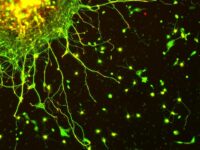Becoming a parent can be one of the most rewarding experiences in life. However, parenting is a physically and financially daunting task that requires careful planning to ensure that a child is safe and will have an enriching life socially, physically, and mentally.
Despite careful planning, children are at risk for a host of developmental disorders. According to the Autism and Developmental Disabilities Monitoring Network, one in every 54 children are on the autism spectrum. In recent years, the rates of autism detection among children ages 5–17 have increased upwards of 2.3% to 2.9%. With diagnostic methods improving over the years, it is essential for parents to be aware that their child may have a different developmental path. One main issue of the current assessment methods is that the age at which parents can access these evaluations for their children is often after their critical period of treatment.
As a pioneer in developmental neuropsychology research, Dr. Renée Lajiness-O’Neill of Eastern Michigan University noticed that many children could be identified as at risk for a disorder much earlier than the conventional 4-5 years. An earlier intervention potentially yields much-improved developmental outcomes for children compared to their later-diagnosed counterparts.
According to Dr. Lajiness-O’Neill, “The critical period for autism treatment is the time within preschool age.” This leads to the fact that “Early detection … can lead to early treatment, which has been shown to improve later language and cognitive abilities and ameliorate … core symptoms.” With access to conventional methods resulting in children potentially missing the critical intervention period, Dr. Lajiness-O’Neil and her team wanted to assess children and their development at their earliest stages.
Recognizing the need to identify neurodevelopmental risks quickly and in a cost-efficient manner, the team decided to begin a development method that has groundbreaking implications, PediaTrac. PediaTrac is a web-based caregiver report method that assesses children in infancy and toddlerhood. By monitoring their speech, motor, and social skills, as well as their sleeping and eating patterns, similar to how a doctor tracks weight and height, the model is able to examine trajectories of change in development in children. Needing to be easily accessible around the world, this method could be implemented online in remote locations where medical attention is scarce. A survey first prompts caregivers with questions during critical developmental periods. The team then uses item response theory, a test construction method that uses mathematical modeling to estimate the child’s ability along a continuum (for example, motor skills), and predictive analytics to identify the child’s developmental and risk status. The team is hoping to expand PediaTrac to include computer adaptive testing (CAT) methods, for which the survey will learn and prompt questions individually based on the child’s developmental status over time.
Being able to collect data at multiple points in a child’s early development helps Dr. Lajiness-O’Neill and her team visualize their growth in a longitudinal manner. Conventional developmental assessments are done in a segmented manner, with information being collected and analyzed at that point in time. With height and weight data being collected in a longitudinal manner, one is able to examine the trajectory of growth over time and analyze the overall growth of the child with multiple points of data. Dr. Lajiness-O’Neill and her team are attempting to apply these methods to other areas of developmental assessment. With the average age of diagnosis for autism ranging between 38 and 120 months, being able to effectively model and predict risk for a diagnosis well before this range can be key in helping a child live their life to their fullest potential.
Following a cohort of newborn babies consisting of 331 term babies and 240 pre-term babies, Dr. Lajiness-O’Neill and her team tested out PediaTrac’s motor domain to assess its efficacy. In addition to the model’s evaluation, the infants underwent direct assessment by professionals to further test PediaTrac’s predictive potential. With PediaTrac, Dr. Lajiness-O’Neill’s team was able to “provide a reliable estimate of the … motor ability during the newborn period” based on caregiver reports and identified risk statuses from the model. With PediaTrac being able to successfully support the early identification of at-risk infants, the implications are monumental. Being an online, not-for-profit service, hospitals around the world can access this revolutionary technology. Its virtual capability allows for the creation of the first-ever repository of normal development data for infants and toddlers that are not bound to just height and weight measurements. Dr. Lajiness-O’Neill and her team’s generosity and ingenuity with the creation and development of PediaTrac can help millions of people find the resources they need and obtain the best quality of life they deserve.
Image courtesy of Flickr


